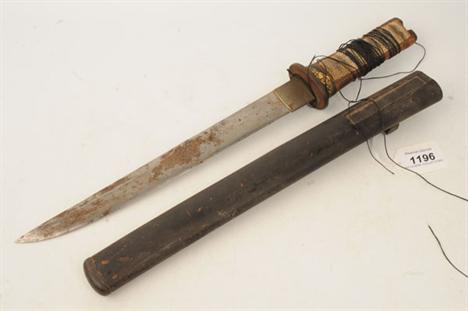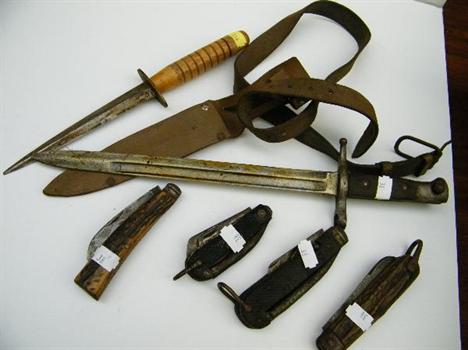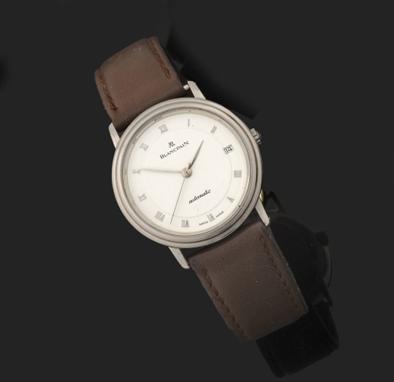A Malayan Kris, with 24cm single edge slightly curved iron blade, the polished wood grip carved as a stylised seahorse with inset ivory eyes, the three piece polished light wood scabbard with well carved swept upper section; a North African Camel Dagger Whip, with plaited leather thong, the wood haft inlaid with mother of pearl and enclosing a stiletto blade (2)
We found 34832 price guide item(s) matching your search
There are 34832 lots that match your search criteria. Subscribe now to get instant access to the full price guide service.
Click here to subscribe- List
- Grid
-
34832 item(s)/page
A GERMAN, THIRD REICH, 1937 PATTERN LUFTWAFFE OFFICER`S DAGGER AND SCABBARD. with etched blade and inscription Fur langjahrige treue dienste der Generalstab, by P D Luneschloss, Solingen, with two braided fabric straps and buckles, the reverse of the clip marked DRGM . ++ In fair to good and entirely original condition. Long in the ownership of the present private vendor
AN INDIAN JADE-HILTED DAGGER, LATE 19TH/20TH CENTURY. with double-edged blade swelling towards the point, formed with a central rib and a pair of tapering fullers on each face, the forte enclosed by a shaped sleeve decorated with gold koftgari scrollwork on each side, finely carved hilt of figured jade, carved with lotus flowers and foliage at the base, the pommel formed as a bridled horse, the eyes set with colourless stones, and the mane extending over the spine. 38cm; 15in
AN INDIAN CARVED ROCK CRYSTAL DAGGER HILT, 18TH CENTURY. of strongly curved rounded form, carved with a band of foliage centring on an expanded flowerhead on each side at the base, and rising to a pommel formed as a bird-of-prey`s head each enriched with gold, and decorated throughout with gilt flowers (areas of wear). 16.5cm; 6 1/2in .
AN INDIAN DAGGER, LATE 19TH CENTURY. with broad serrated double-edged blade cut with a pair of long fullers on each side, swelling at the forte and decorated with gold koftgari foliage and a calligraphic cartouche on each side, iron hilt including a pair of down-curved bud-shaped quillons, double-beaked pommel, and decorated over its surface with leafy ornament en suite with the forte, in its fabric-covered wooden scabbard. 55.3cm; 21 3/4in
A VERY FINE AND RARE TURKISH GOLD, ENAMELLED AND GEM-SET DAGGER WITH LAPIS LAZULI HILT, EARLY 18TH CENTURY. with tapering single-edged blade of watered steel, decorated on one side with a gold-encrusted scroll and a spray of tulip flowers, gold ferrule (incomplete), faceted hilt of gold-flecked lapis lazuli (one small chip at the base), rising to a beaked pommel set with a ruby in a raised floral gold setting, in its original gold scabbard, the inner face enamelled in polychrome with a vertical arrangement of conventional flowers with sprays of foliage highlighted with green enamelled leaves (the enamel with small losses), all against a finely punched matted ground, the outer face decorated with a large panel top and bottom filled with floral patterns formed of raised gold settings and twenty four and twenty six rubies respectively, all enriched with black and white enamel and each with a single diamond, the middle portion with a further flower formed of six diamonds centring on a ruby surrounded by enamelled polychrome flowers and foliage against a finely punched ground en suite with the inner face, the chape set with a single emerald, the back-edge of the scabbard with a running pattern of enamelled green foliage (losses), the inner face with characteristic locket and retaining its original plaited silver wire suspension cord with fluted bulbous finial. 17.5cm; 6 7/8in. The floral mount for the pommel stone and the outer face of the scabbard are closely related to another gold, enamelled and gem-set dagger of earlier form, taken as part of the booty gathered by the Margraves of Baden-Baden and Baden-Durlach now preserved in the Badisches Landesmuseum, Karlsruhe. See E. Petrasch, R. Sänger, E. Zimmermann and H. G. Majer 1991, p. 197, no. 143. Lapis Lazuli is most commonly found in the valley of Kokcha, a tributary of the Oxus, south of Firgamu in Afghanistan. It was visited by Marco Polo in 1271 and has been prized both before and since that date for its rich blue colour characteristically flecked with gold specks of pyrite.
A TURKISH YATAGHAN AND AN ENAMELLED ARAB DAGGER, 18TH AND 19TH CENTURIES. the first with slightly curved single-edged blade, brass hilt and a pair of slender horn grip-scales rising to an eared pommel; the second with curved double-edged blade decorated with gold koftagri at the forte, and enamelled copper grip and scabbard decorated with stylised flowers on a polychrome ground (worn). the first: 66cm; 26in blade. (2)
THE LAMBLE COLLECTION. A BHUTANESE DAGGER, LATE 19TH CENTURY AND A GURKHA KUKRI KNIFE. the first with straight blade from a regulation bayonet, double-edged towards the point, white metal hilt of characteristic form including two beadwork collars, the grip bound with plaited wire, in its original scabbard with fabric loop for suspension; the second of characteristic form, with broad curved blade, hardwood grip, in its scabbard (accompanying knives and pouch missing). the first: 36cm; 14 1/8in . (2)
A RONDEL DAGGER FORMED ENTIRELY OF STEEL, PROBABLY LATE 15TH CENTURY. with stout three-stage blade reinforced at the tip, formed with a slender fuller along the hollowed back-edge on one side, inlaid in latten with the bladesmith`s mark, the letter `I` at the forte, the hilt formed of a disc top and bottom of differing size, each engraved with delicate foliage around the edge, the upper with spiralling lines and retained by a foliate copper rivet, and fluted grip engraved with pairs of spiralling lines. 35cm; 13 3/4in
A GERMAN LEFT-HAND DAGGER, CIRCA 1600. with robust tapering blade of diamond-section, inlaid in latten with the bladesmith`s mark, a crowned cross and orb, on one side, rectangular ricasso hollowed for the thumb, steel hilt comprising a pair of vertically recurved forward-canted flattened quillons with bud-shaped terminals, off-set side-ring interrupted by a circular moulding, associated fluted globular pommel, and later spirally-carved wooden grip (areas of pitting). 48cm; 18 7/8in . Provenance. Sotheby Parke Bernet, 14th October 1975, lot 324. Literature. Leslie Southwick, The Price Guide to Antique Edged Weapons, 1982, p. 201, no. 584.
A FINE AND VERY RARE GARNITURE OF A CUP-HILT RAPIER AND LEFT-HAND DAGGER, THIRD QUARTER OF THE 17TH CENTURY, SPANISH OR ITALIAN. the rapier with blade of flattened-hexagonal section, stamped `LHPHS` and `AGHAE` between a series of decorative marks within a short fuller on the respective sides, steel hilt comprising cup-guard pierced and chiselled with a symmetrical arrangement of tightly scrolling leafy tendrils bound together by ropework bands, strongly moulded rompepuntas chiselled with an alternating arrangement of plain and foliate panels, guardapolvo pierced and chiselled with further designs of scrolling leafy tendrils enclosing expanded flowerheads all framed by bands of pellets and acanthus, a pair of straight tapering writhen quillons en suite with the brim and chiselled with expanded flowerheads on the terminals, chiselled écusson, a pair of plain arms, knuckle-guard matching the quillons, spirally moulded bun-shaped pommel, and the grip bound with plaited copper wire with a steel collar top and bottom, perhaps the original, the dagger with very slender three-stage blade, the upper portion of stiff diamond section, the middle and lower each with blunt edges chiselled with blade catching ridges and stamped with decorative circles on each face, rectangular ricasso hollowed for the thumb, formed with a pair of rings at the top and two pairs of notches for blade catching at the base, stamped with the bladesmith`s mark, the letter `B` on one side and stamped with pellets, steel hilt comprising a pair of straight quillons, curved triangular guard with strongly moulded rompepuntas, and spirally-fluted pommel, all pierced and chiselled en suite with the rapier, and the grip with later binding of plaited copper wire with a steel collar top and bottom (the tang slightly shortened), and each remaining in fine condition throughout. the rapier: 99cm; 39in blade. the dagger: 59cm; 23 1/4in . (2). Provenance. Roy Cole, Ontario, sold Sotheby & Co., 12th October 1970, lot 264.
A RARE SPANISH LEFT-HAND DAGGER, DATED 1683. with tapering blade of triangular-section, formed with a flattened back-edge, etched with scrolls of foliage, the bladesmith`s name `Fran Durin Ensi vied 1683` (rubbed), recessed with a pair of crescentic apertures at the base for blade-catching, rectangular ricasso formed with a notched edge, recessed for the thumb on the inner face and decorated with the sacred monogram `IHS` on the outer face, steel hilt comprising a pair of straight quillons decorated with a writhen pattern and with fluted button terminal, triangular outer guard decorated with a radiating pattern of lozenge frames and with bold rompepuntas decorated with a pattern of roping, compressed fluted button-shaped pommel, and spirally-fluted grip with later leather covering. 62.5cm; 24 5/8in
A NORTH EUROPEAN DAGGER, LATE 17TH CENTURY. from a cut-down small-sword, with tapering blade cut with a long fuller, pierced over the greater part of its length with a series of slots and circles, steel hilt including a pair of recurved quillons with globular terminals, and horn grip carved as an Eastern potentate (patinated, grip cracked). 37cm; 14 5/8in. Provenance. Weller & Dufty, 21st March 1973, lot 836
A DECORATIVE DAGGER BY GEORGE WOSTENHOLM, SHEFFIELD, LATE 19TH CENTURY. with robust blade of diamond section, cut with a short fuller on each side, stamped with the maker`s details `G. Wostenholm & son, Washington Works, Sheffield` on one side and `I*XL` on the other at the forte, brass hilt cast in relief, comprising an African Hunter holding a German silver spear and arrow forming the grip, the cross-piece formed as a pair of hound`s heads, in its scabbard decorated with an eclectic blend of tribal and renaissance motifs. 25.4cm; 10in
A SPANISH SILVER-MOUNTED DAGGER, 19TH CENTURY. with double-edged fullered blade of flattened-diamond section, the central fuller pierced with a series of slots and circles, silver-gilt hilt including a pair of down-curved quillons decorated with scrolls and an owl in the centre on each side, and nielloed grip decorated with foliage and a trellis pattern filled with crosses, in its fabric-covered wooden scabbard with silver mounts en suite with the hilt. 25cm; 9 7/8in
A Fine Set of 9 Carat Gold Cufflinks & Tie Pin presented as a gift from the Sultan of Oman and crafted as his Coat of Arms. The tie clip having five amethysts and two diamonds set in the white gold khanjar dagger & sheath; with two crossed swords incorporating twenty six brilliant cut diamonds. The matching cufflinks each set with three amethysts and twenty one diamonds.
Four assorted gem set brooches, including a hoop brooch set with alternate circular aquamarines and seed pearls, 24mm wide; together with a seed pearl set naval crown bar brooch, 50mm wide; together with a diamond and seed pearl set star and crescent brooch, 40mm wide; together with a Scottish hardstone dagger brooch, mounted with a multi-faceted amethyst, 50mm wide (4).
A 9ct Gold Wristwatch, signed Jaeger LeCoultre, 1958, (calibre P480/C) nickel finished lever movement numbered 1349810, silvered dial with applied dagger markers, subsidiary seconds, case with unusual small rounded lugs, snap-on back, London 1958 and numbered 8475, 34mm wide see illustration
An 18ct Gold Wristwatch, signed Longines, 1964, (calibre 30L) 17-jewel lever movement numbered 9729688, textured silvered dial with applied Arabic and dagger markers, subsidiary seconds, case with snap-on back numbered 6691 1 818, London import marks for 1964, 37mm wide, together with original purchase receipt, guarantee dated 1966 and jeweller`s watch case see illustration
A Stainless Steel Calendar Chronograph Wristwatch, signed Cartier, model:Chronoscaph 21, circa 2000, quartz movement, Cartier monogrammed dial with luminous dagger markers, three subsidiary dials for seconds, 30-minute and 10 hour registers, date aperture beneath magnifying glass, case with screw-down crown, buttons in the band to operate chronograph, bezel with Roman numerals, case back secured by eight screws, Cartier steel and rubber bracelet with concealed deployant clasp, 38mm wide see illustration
An 18ct Gold Wristwatch, signed Rolex, Precision, 1957, 17-jewel lever movement, blued overcoil hairspring, silvered dial with applied dagger and baton markers, subsidiary seconds, case with snap-on front, inside case back stamped RWC and Glasgow import marks for 1957 and numbered 893 9320, Rolex strap and gilt buckle, 34mm wide see illustration
-
34832 item(s)/page

























